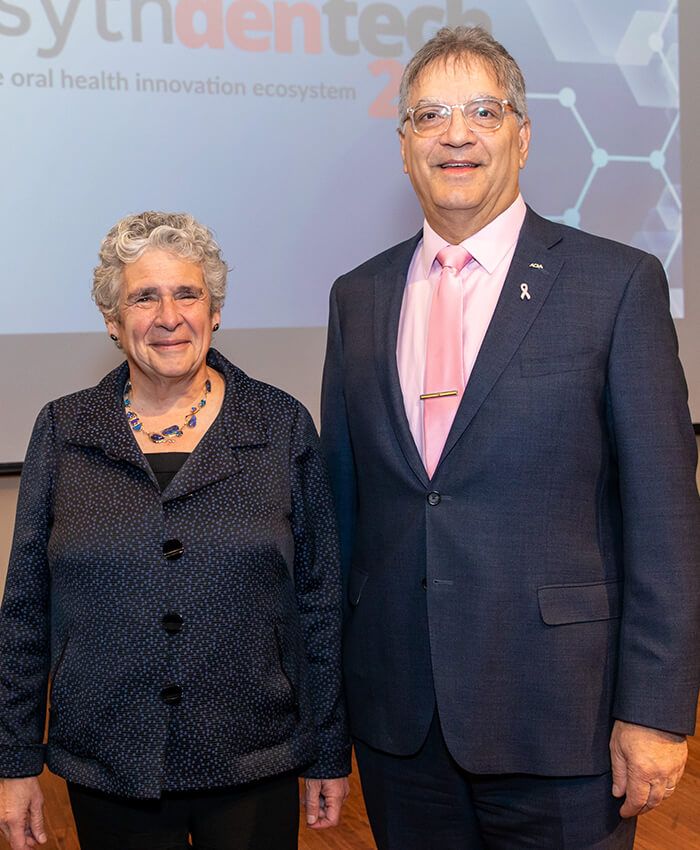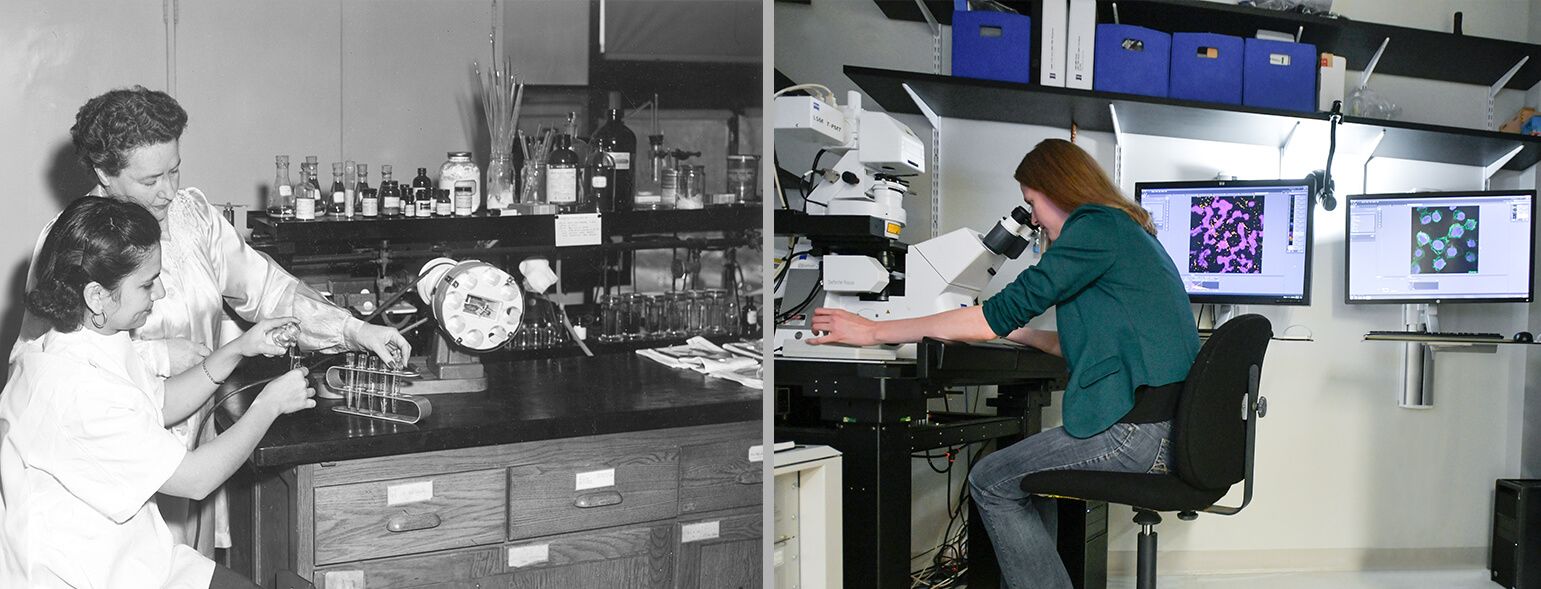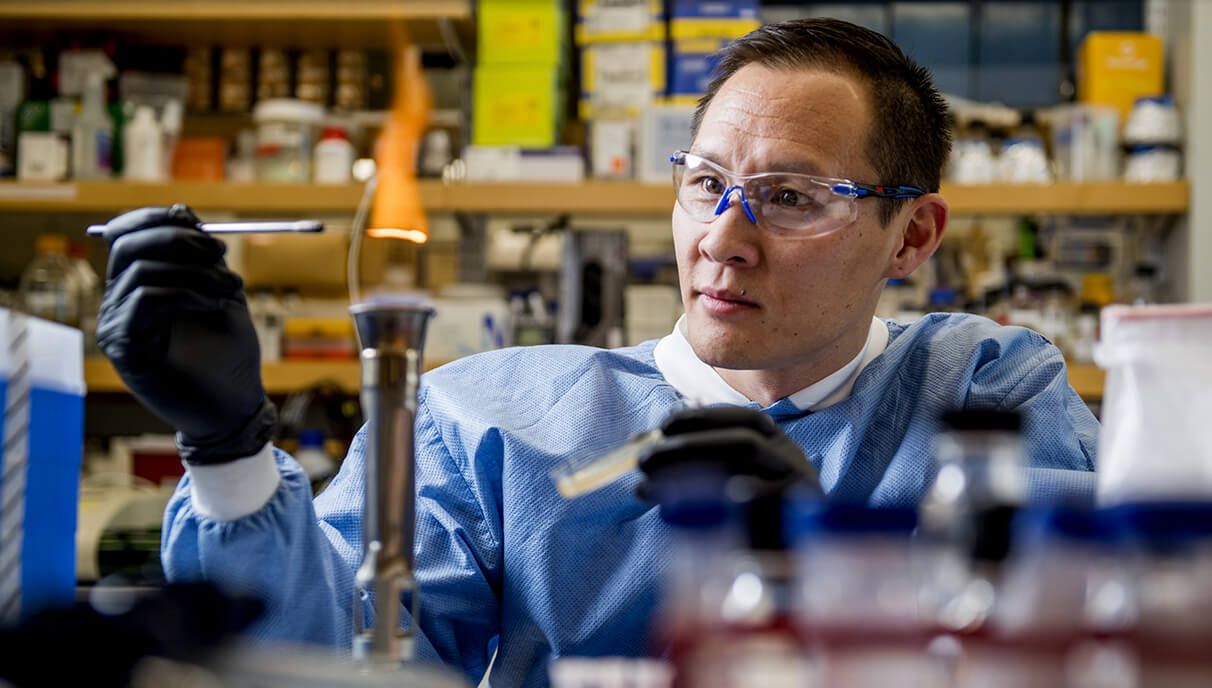By Jerry Markon
The recent merger of the American Dental Association with the Forsyth Institute promises to give a jolt to dental R&D in the years ahead—both research for its own sake and the applied variety undertaken in pursuit of patents and profits. How did the tie-up come together, and what are its prospects for success? The principals—and some interested outsiders—explain their thinking.

Partners: Forsyth Institute board chair Elyse Cherry with ADA executive director Raymond Cohlmia
IT WAS A chance meeting that didn’t happen by chance.
At the 2023 School of Dentistry Research Day conference last March at the Oregon Health & Science University in Portland, the leader of the nation’s largest professional dental organization and the head of a prominent oral health research institution happened to speak one after the other.
When the symposium was over, Dr. Wenyuan Shi—president and CEO of the Forsyth Institute—approached Dr. Raymond Cohlmia, who has been executive director of the American Dental Association since November 2021. Dr. Shi proposed that the two organizations they oversee consider becoming some kind of combined entity.
It wasn’t fate, exactly, but “the conversation just kind of sparked,” Dr. Cohlmia, 62, recalls.
Barely seven months later, after negotiations that both sides describe as extraordinarily smooth—a hostile leveraged buyout this was not—the Chicago-headquartered ADA and the Forsyth Institute, based in the Boston area, announced a merger that they say has the potential to transform dental research and oral health overall. The union brings together Forsyth and the ADA’s own research arm, the ADA Science & Research Institute, into a combined entity now called the ADA Forsyth Institute. Dr. Shi, 61, will be its CEO; Dr. Cohlmia will chair the new seven-member board post-merger.
When the merger was announced and formally took effect late last October, the parties (and adjacent outsiders) offered no shortage of superlatives. Even Massachusetts Governor Maura Healey weighed in with a statement of support, citing Forsyth’s century-plus “of excellent work right here in Massachusetts.” Said Forsyth board chair Elyse Cherry: “We believe the ADA Forsyth Institute will accelerate the pace of scientific discovery and innovation for generations to come.”
A half-year later, the parties continue to speak expansively about transformative research, with Dr. Cohlmia saying the tie-up will help expand the ADA’s famed Seal of Acceptance program to include new dental materials that will enable clinicians to treat patients more effectively.
The research specifics remain unclear, but coming into sharper focus are the origins of a merger whose consummation surprised much of the dental research world. And even though the Shi-Cohlmia chat on the sidelines of the Oregon conference was not planned, the combination of these two well-known entities was not as sudden as it might first have appeared.
We believe the ADA Forsyth Institute will accelerate the pace of scientific discovery and innovation for generations to come.
–Elyse Cherry
Forsyth Institue Board Chair
Critically, for Forsyth, the merger offered a lifeline of sorts. Facing financial difficulties in recent years stemming from what its board considered an overreliance on basic research at the expense of more remunerative applied research, the institute had been in merger negotiations with a handful of entities for more than a year, Dr. Shi told Incisal Edge in a recent joint interview with Dr. Cohlmia.
Dr. Shi, who arrived at Forsyth in 2017 with what he describes as a mandate to “not only continue doing basic research but also actively translating that into innovation activity as a new revenue source,” calls the partnership with the ADA “a miracle,” adding that “it does have a serendipity part of it, but it’s also very strategic.”
Joining forces with Forsyth also fit with the ADA’s strategy, says Dr. Cohlmia, who had put together a five-year business plan that included “joining and working with other entities to grow research, to really make a public impact.” Among the people he had hoped to work with: the man who is now his compatriot. “I’ve known Dr. Shi for years,” Dr. Cohlmia says. “He has been a mentor of mine, and it’s incredible what he does.”
Dr. Parag Kachalia, chief clinical officer of Seattle Study Club, the international network of dental professionals (and No. 19 on Incisal Edge’s 2023 list of the 32 Most Influential People in Dentistry), says the merger “looks like a very positive step for dentistry, but
the onus is really on the ADA to make this a clear benefit for its members from the standpoint of [affecting] oral health.” He praises the Forsyth Institute as a fount of world-class research but points to a “massive disconnect from the general academic population. The average dentist does not get a monthly Forsyth update. You have to go digging for the research.”

Now and Then: Forsyth research spans decades.
Ideally, Dr. Kachalia says, that’s where the ADA will come in. He has called on Dr. Cohlmia’s organization “to disseminate that [research] information appropriately,” especially to affect low insurance reimbursement rates for dentists by helping reinforce the notion that more, and more frequent, preventative dental care is no less critical to health than any other kind of medical treatment. The combined entity, he adds, “has to hold true to [Forsyth’s] initial mission”—to pursue lines of inquiry regardless of a potential payoff down the road. “The research they are doing now should not be influenced by dollars that may be available.”
The ADA Science & Research Institute (ADASRI), based primarily in Chicago and Gaithersburg, Maryland, conducts oral health research designed to improve patient care and test dental products and materials. While its efforts have included the first complete mapping of every cell in the oral cavity and the creation of evidence-based guidance to inform patient treatment, the ADA is perhaps best known on the research front for its Journal of the American Dental Association, published since 1913, and the Seal of Acceptance program.
Dating to 1931 and formed to assess and clarify often-extravagant claims about what dental products could do, the Seal of Acceptance program now verifies more than 400 over-the-counter consumer dental products a year for safety and effectiveness. With the merger, the ADASRI’s existing research will continue and be folded into the broader ADA Forsyth entity, ADA officials say.
The Forsyth Institute brings to the link-up an equally illustrious research pedigree. Founded in 1910 as a pediatric dental hospital serving disadvantaged children in the Boston area, it gradually broadened its remit to a wider oral health and wellness mission. It published its first research paper in 1915, in response to the realization that standard drilling and filling wasn’t helping prevent recurring caries in its patient populations. Clinical care continued as its research arm grew, according to Forsyth officials; in 2000, the clinical side was relegated to the mobile dental program ForsythKids. The institute’s key findings over the years—in part stemming from its development of the first anaerobic chamber—include the first local antibiotic to treat gum disease and the discovery that cavities are the result of bacterial infection, both of which happened over the course of the 1950s and ’60s.
By the middle of the last decade, however, Forsyth was facing financial problems stemming largely from its nonprofit status, Dr. Shi says. “The institute had been doing basic research for the last 100 years, and for a while it was very easy to maintain a nonprofit organization. These days, it’s harder and harder,” he says, citing skyrocketing costs both administrative and for equipment. “Many nonprofit dental organizations have closed.”
In 2017, Forsyth’s board changed course. The institute’s longstanding affiliation with Harvard University had ended in late 2015, and the board decided “to not only publish nature science papers but also very actively translate our discoveries into practical applications,” says Dr. Shi, who was hired as part of that initiative in August 2017.
The board put him in charge of doing more applied research and looking for a partner “who had the resources and network to bring our innovation to a new level.”
That shift in direction was symbolized by Forsyth dentech, an oral health technology conference and investment forum the institute launched in 2021, bringing together researchers, investors and inventors. “Oral health technology is a largely untapped $100 billion–plus market with incredible potential for growth,”
Dr. Shi said in a news release announcing the 2022 forum. Now called ADA Forsyth dentech, the symposium remains a going concern; its 2024 conference will be held in Somerville, Massachusetts—just across the Charles River from Boston—in October.
The Forsyth Institute’s federal tax filing for the 2021 calendar year, the most recent available, shows total revenue of $21.7 million, lagging expenses of $26 million. It did, however, boast $37.3 million in total assets against $8.3 million in liabilities. The American Dental Association, with 159,000 members, is a much larger organization. Its 2022 revenue, filings show, was $138.7 million, with expenses of $142.2 million. Total ADA assets stood at $218.7 million against $74.1 million in liabilities.

Business of discovery: It’s too early to suppose how Dr. Batbileg Bor’s work on the recently discovered TM7 bacteria and its potential links to mucosal diseases might someday be applied, let alone monetized.
Dr. Shi would not disclose the identities of the four or five interested parties that emerged from Forsyth’s search for a suitor but said the ADA always stood out in his mind: “They are the 800-pound gorilla in the field.”
He was able to act on that impulse at the Oregon conference in March 2023, where he spoke about Forsyth’s contributions to the dental industry following Dr. Cohlmia’s discussion of his strategic plan for the ADA. Dr. Shi approached him, Dr. Cohlmia recalls, and “said, ‘What if we start talking about coming together?’ ”
Both sides quickly realized the potential synergistic benefits. “We could see at that moment that merging was so natural,” Dr. Shi says. “They have their own research institute, but adding the power of Forsyth—that would change the game.”
Dr. Cohlmia concurs. “Working together with Forsyth really opens up the envelope of what we can do—not just for members but for our entire profession in changing people’s lives,” he says. “We make people healthy. It’s as simple as that.”
Then, crucially, there were the financial benefits for Forsyth. Such research institutions, Dr. Cohlmia says, often don’t get funding to cover basic overhead—such as a human resources department or even the monthly electric bill—that larger organizations take care of in-house. “That’s where the ADA comes in,” Dr. Cohlmia says. “You have to have funding to support the research process. [The merger] became the perfect opportunity to advance [Forsyth’s] research, support the mission and help them with day-to-day overhead.” For its part, the ADA, Dr. Cohlmia says, will be able to have its researchers do more innovative work, likely redounding to the benefit of its members and advancing oral and whole-body health as well.
As such, talks proceeded swiftly, with both groups’ boardssigning on. “I think we probably set a world record for two organizations this size to finish the process in less than two months,” Dr. Shi says. “I got zero resistance from my board. It was a no-brainer.”
Now, the new partners are in the process of integrating theirresearch staffs and operations into the new ADA Forsyth Institute and have been searching for a new facility in the Boston area. Officials say they have identified a location in Somerville.
The ADA Science & Research Institute has been spread over several locations, and the merger presents a chance to consolidate them into one setting for greater efficiency. “We’ve had different visions in our research areas, and theyweren’t communicating so well,” Dr. Cohlmia says.
It’s unclear if any job losses lie ahead, though officials say the combined ADA Forsyth begins with 140 employees, 120 of whom are researchers, figures that are expected to grow substantially.
This looks like a very positive step for dentistry, but the onus is really on the ADA to make this a clear benefit for its members from the standpoint of affecting oral health.”
DR. PARAG KACHALIA
Chief clinical officer, Seattle Study Club
The specific research focus of the combined entity is under discussion, with the new organization currentlydeveloping a business plan. Beyond expanding the ADA Seal of Acceptance program, Dr. Cohlmia promises “innovative, evidence-based research” that improves public health—and focuses on dentists. “We have to improve the dental profession to make sure dentists have the right materials, the right techniques,” he adds. “That’s exactly what we’re doing with ADA Forsyth.”
The Seattle Study Club’s Dr. Kachalia says the ADA-Forsyth linkage, like any merger, brings opportunities but also risks. “Any differences don’t always have to be solved, but you need at least a frank understanding of each other.” Think of the difficulties that attended the ballyhooed Dentsply-Sirona merger some years ago. Dr. Kachalia knows whereof he speaks, too: SSC is in the middle of its own transition, having formed a partnership in 2022 with Overjet, the noted dental AI solutions provider whose cofounder and CEO, Wardah Inam, has appeared regularly in the pages of Incisal Edge. “If [frank understanding] doesn’t happen,” Dr. Kachalia continues, “the risk is obvious. You won’t leverage anything. You’ll just have two entities under a common roof, and it’s kind of business as usual.”
Working together with Forsyth really opens up the envelope of what we can do—not just for members but for our entire profession in changing people’s lives. We make people healthy. It’s as simple as that.
– Dr. Raymond Cohlmia
Executive Director, American Dental Association
Drs. Shi and Cohlmia voice optimism at the prospects for the nascent ADA-Forsyth. “Obviously different organizations run their own ways,” Dr. Shi says. “There will be cultural differences. But the commitment is so high at every level to try to make this work.”
Even as Forsyth lifts off further under the ADA’s wing, to a degree, Dr. Cohlmia pays tribute to the institute’s “long and rich history. This history needs to remain,” he says. “We don’t ever want to lose the historical reverence for what the Forsyth Institute was.”
Photographs courtesy of the ADA Forsyth Institute



